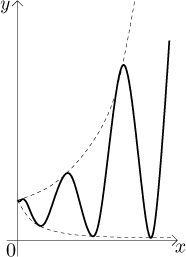Problem: Evaluate (if it exists) the limit

Solution:
This is a standard problem, we want to find a limit at infinity of an
expression that exists on a neighborhood of infinity (note that
3/2 + sin(x) > 0, so there will be no trouble when we change this
general power into its
canonical "e to ln" form). Thus we start by substituting infinity.

The expression N∞ is indeterminate (see the
algebra of N). When we
change this general power into the canonical form, we get
exln(3/2 + sin(x)), after substituting infinity
we get ∞⋅ln(N) in the exponent, which is no help.
Thus standard methods fail and we need to look at the expression closer. What
happens as x goes to infinity? The expression
3/2 + sin(x) keeps
oscillating between 1/2 and 5/2 and we are raising these numbers to the power
x. Thus the given expression sometimes looks like
(1/2)x, sometimes like
(5/2)x, and most
of the time it looks like something between (in fact the graph of the given
expression oscillates between the two exponentials).
Since |1/2| < 1, the exponential
(1/2)x tends to zero at
infinity. On the other hand, since 5/2 > 1, the exponential
(5/2)x tends to infinity at infinity. The given expression
oscillates between these two curves, therefore we would guess that it has no
limit at infinity.

How would we prove it? The easiest way is to use the
Heine theorem. We will consider
two sequences that tend to infinity. With one sequence we will hit the tops,
with the other the dips to show that the given expression has two different
tendencies as x goes to infinity.
First, define xn = π/2 + 2nπ.
Then
xn→∞.
When we
substitute it into the given expression f (x), we get
f (xn) = (5/2)π/2 + 2nπ→∞
as n goes to infinity.
On the other hand, we define
yn = 3π/2 + 2nπ.
Then
yn→∞.
When we
substitute it into the given expression f (x), we get
f ( yn) = (1/2)3π/2 + 2nπ→0
as n goes to
infinity.
If f had a limit at infinity, then this limit would have to be equal
to both infinity and 0, which is a contradiction.
For a different look at this example, see
this problem in
Sequences - Solved Problems - Limits.
Back to Solved Problems - Limits
![]()
![]()
